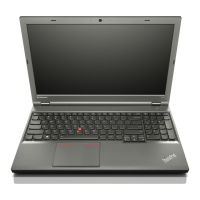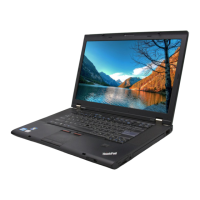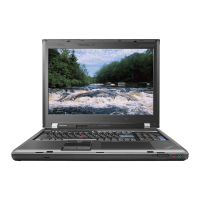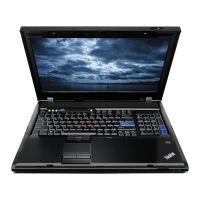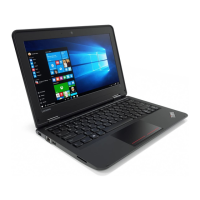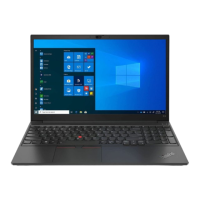Do you have a question about the Lenovo ThinkPad W541 and is the answer not in the manual?
Safety guidelines for preventing heat damage, liquid spills, and cable damage.
Proper methods for handling, moving, and carrying the computer to prevent damage.
Key safety notices and conditions requiring immediate action for safe operation.
Identification of computer components, ports, and status indicators across various views.
Details on product labels, specifications, memory, storage, display, keyboard, interface, and wireless features.
Overview of preinstalled Lenovo software and how to access them on different Windows versions.
Guidance on registering the computer and finding answers to frequently asked questions for optimal use.
Explanation of special keyboard keys, TrackPoint, trackpad, and their gestures.
Strategies for managing power, checking battery status, and maximizing battery life.
Instructions for establishing Ethernet, wireless LAN, WAN, Bluetooth, and NFC connections.
Connecting projectors, external monitors, using audio features, and the camera.
Setting up, changing, and removing various system passwords for enhanced security.
Securing data with disk encryption, BitLocker, and utilizing the security chip.
Enrolling fingerprints, using the reader, and securely deleting data before disposal.
Information on recovering the operating system, refreshing, or resetting the computer to factory defaults.
Steps to create and use recovery media for system restoration.
Procedures for backing up system data and performing recovery operations.
Precautions against static electricity and detailed steps for replacing the battery pack.
Instructions for replacing SIM card, Ultrabay devices, memory modules, and storage drives.
Steps for replacing wireless LAN/WAN cards, coin-cell battery, and keyboard.
Procedures for installing new OS versions and essential device drivers for system functionality.
Navigating the BIOS setup, configuring main menu items, and understanding config options.
Tips for preventing common issues, keeping drivers current, and general computer care.
Using diagnostic tools, interpreting error messages, and addressing common system errors.
Resolving problems with keyboards, pointing devices, displays, audio, and power systems.
Addressing issues with hard drives, SSDs, optical drives, and network connections.
Collecting necessary details about the computer and the problem before contacting support.
Information on accessing technical assistance via web, phone, and purchasing additional services.
Details on wireless standards, usage environments, and antenna placements.
Information on product certifications, export classifications, and electronic emission compliance.
Guidelines for responsible recycling of electronic equipment according to WEEE regulations.
Details on Lenovo's compliance with the EU RoHS directive and other regional regulations.
Information on ENERGY STAR qualification and preset power management features for energy efficiency.
List of trademarks and important legal notices regarding the document and product.
Safety guidelines for preventing heat damage, liquid spills, and cable damage.
Proper methods for handling, moving, and carrying the computer to prevent damage.
Key safety notices and conditions requiring immediate action for safe operation.
Identification of computer components, ports, and status indicators across various views.
Details on product labels, specifications, memory, storage, display, keyboard, interface, and wireless features.
Overview of preinstalled Lenovo software and how to access them on different Windows versions.
Guidance on registering the computer and finding answers to frequently asked questions for optimal use.
Explanation of special keyboard keys, TrackPoint, trackpad, and their gestures.
Strategies for managing power, checking battery status, and maximizing battery life.
Instructions for establishing Ethernet, wireless LAN, WAN, Bluetooth, and NFC connections.
Connecting projectors, external monitors, using audio features, and the camera.
Setting up, changing, and removing various system passwords for enhanced security.
Securing data with disk encryption, BitLocker, and utilizing the security chip.
Enrolling fingerprints, using the reader, and securely deleting data before disposal.
Information on recovering the operating system, refreshing, or resetting the computer to factory defaults.
Steps to create and use recovery media for system restoration.
Procedures for backing up system data and performing recovery operations.
Precautions against static electricity and detailed steps for replacing the battery pack.
Instructions for replacing SIM card, Ultrabay devices, memory modules, and storage drives.
Steps for replacing wireless LAN/WAN cards, coin-cell battery, and keyboard.
Procedures for installing new OS versions and essential device drivers for system functionality.
Navigating the BIOS setup, configuring main menu items, and understanding config options.
Tips for preventing common issues, keeping drivers current, and general computer care.
Using diagnostic tools, interpreting error messages, and addressing common system errors.
Resolving problems with keyboards, pointing devices, displays, audio, and power systems.
Addressing issues with hard drives, SSDs, optical drives, and network connections.
Collecting necessary details about the computer and the problem before contacting support.
Information on accessing technical assistance via web, phone, and purchasing additional services.
Details on wireless standards, usage environments, and antenna placements.
Information on product certifications, export classifications, and electronic emission compliance.
Guidelines for responsible recycling of electronic equipment according to WEEE regulations.
Details on Lenovo's compliance with the EU RoHS directive and other regional regulations.
Information on ENERGY STAR qualification and preset power management features for energy efficiency.
List of trademarks and important legal notices regarding the document and product.
| Form factor | Clamshell |
|---|---|
| Product type | Mobile workstation |
| Product color | Black |
| Bus type | DMI2 |
| Tjunction | 100 °C |
| Processor cache | 8 MB |
| Processor cores | 4 |
| Processor model | i7-4940MX |
| System bus rate | 5 GT/s |
| Processor family | Intel® Core™ i7 X-series Extreme Edition |
| Processor socket | Socket G3 |
| Processor threads | 8 |
| Processor codename | Haswell |
| Processor frequency | 3.1 GHz |
| Processor cache type | L3 |
| Processor lithography | 22 nm |
| Processor manufacturer | Intel |
| Processor front side bus | - MHz |
| PCI Express slots version | 3.0 |
| Processor boost frequency | 4 GHz |
| Processor operating modes | 64-bit |
| ECC supported by processor | No |
| PCI Express configurations | 1x16, 2x8, 1x8+2x4 |
| Thermal Design Power (TDP) | 57 W |
| Maximum number of PCI Express lanes | 16 |
| Motherboard chipset | Intel® QM87 |
| Memory slots | 4x SO-DIMM |
| Internal memory | 32 GB |
| Memory clock speed | 1600 MHz |
| Memory form factor | SO-DIMM |
| Internal memory type | DDR3L-SDRAM |
| Memory layout (slots x size) | 4 x 8 GB |
| SSD capacity | The Solid State Drive's storage capacity in Gigabytes. |
| SSD interface | SATA III |
| Storage media | SSD |
| Optical drive type | DVD±RW |
| Card reader integrated | Yes |
| Total storage capacity | 512 GB |
| Compatible memory cards | MMC, SD, SDHC, SDXC |
| Number of SSDs installed | 1 |
| Display surface | - |
| Display diagonal | 15.5 \ |
| Display resolution | 2880 x 1620 pixels |
| Native aspect ratio | 16:9 |
| Discrete graphics card model | NVIDIA® Quadro® K2100M |
| On-board graphics card model | Intel® HD Graphics 4600 |
| Discrete graphics card memory | 2 GB |
| On-board graphics card family | Intel® HD Graphics |
| On-board graphics card base frequency | 400 MHz |
| On-board graphics card dynamic frequency (max) | 1350 MHz |
| Intel segment tagging | Professional |
| Intel® Virtualization Technology (Intel® VT) | VT-d, VT-x |
| Audio system | Dolby Home Theater |
| Wi-Fi standards | 802.11a, Wi-Fi 5 (802.11ac), 802.11b, 802.11g, Wi-Fi 4 (802.11n) |
| Bluetooth version | 4.0 |
| Ethernet LAN data rates | 10, 100, 1000 Mbit/s |
| Charging port type | DC-in jack |
| HDMI ports quantity | 0 |
| USB 2.0 ports quantity | 2 |
| Recovery operating system | Windows 8.1 Pro |
| Operating system installed | Windows 7 Professional |
| Processor ARK ID | 78940 |
| Processor package size | 37.5 x 37.5 x 4.7 mm |
| Supported instruction sets | AVX 2.0, SSE4.1, SSE4.2 |
| Battery capacity | 99.9 Wh |
| Battery life (max) | 11.1 h |
| Number of battery cells | 9 |
| AC adapter power | 170 W |
| Sustainability certificates | RoHS, EPEAT Gold, ENERGY STAR |
| Depth | 248.1 mm |
|---|---|
| Width | 376.6 mm |
| Weight | 2700 g |
| Height (rear) | 29.5 mm |
| Height (front) | 27.9 mm |
